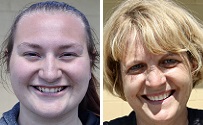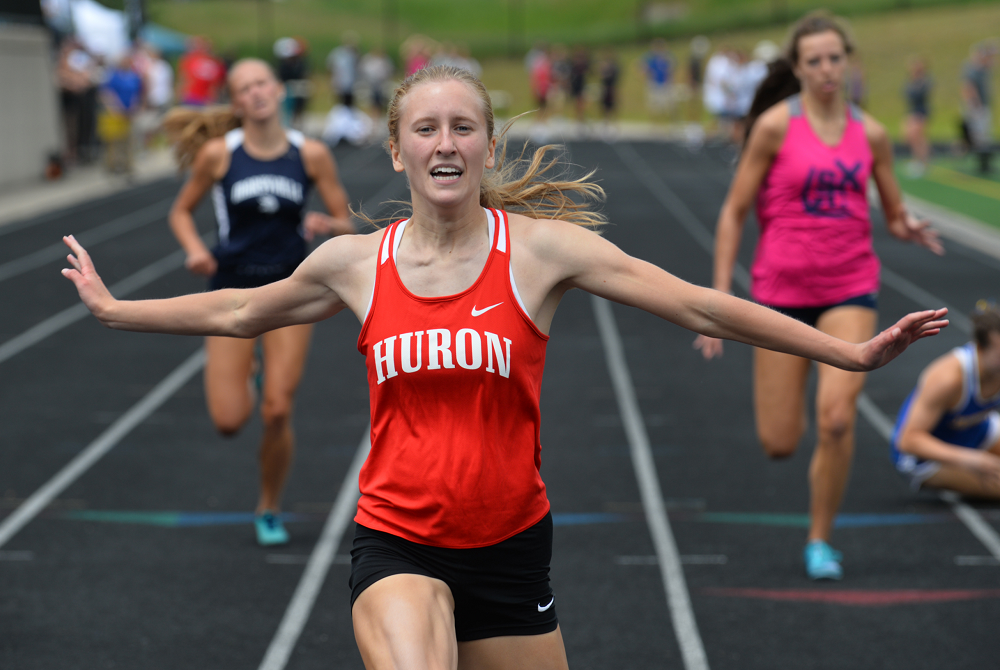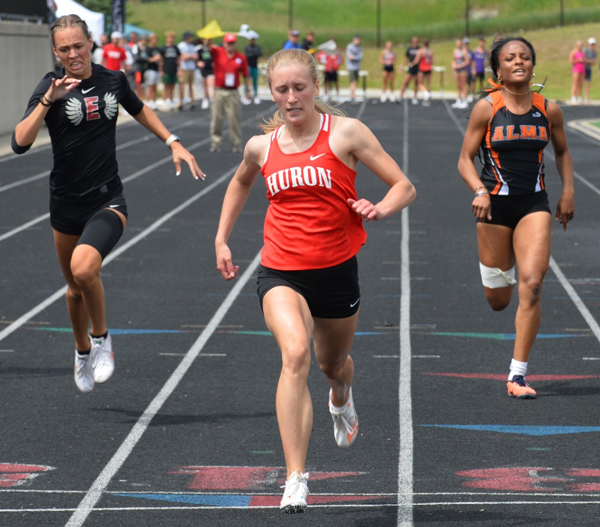
In Just 2nd Season, Van Dyk Breaks Decades-Old K-Christian Throws Records
By
Pam Shebest
Special for MHSAA.com
June 9, 2022
KALAMAZOO — When an exuberant Tess Van Dyk broke the shot put record at Kalamazoo Christian earlier this year, the senior was thrilled at reaching one of her high school goals.
 For her throws coach, Tracy (Rozema) Jackson, the achievement was bittersweet.
For her throws coach, Tracy (Rozema) Jackson, the achievement was bittersweet.
Jackson was the previous record-holder with a put of 41 feet, 6 inches, and knew that record was in jeopardy when she saw Van Dyk’s numbers a year ago.
“I thought, just wait and be prepared for it,” Jackson said. “It was kind of something sentimental. That record had been in place for 34 years. I set it in 1988.”
Van Dyk actually broke the record twice.
She put the shot 42 feet, 6 inches, to snap Jackson’s record, then the same day, threw the current mark of 42-9.
That happened during a dual meet April 21, and was just the start of a stellar year.
Van Dyk also shattered the previous discus throw record of 127 feet, 3 inches, set by Sandy (Wolthuis) George in 1978.
Van Dyk’s record-setter was 134-6, tossed at the Southwestern Athletic Conference championship meet May 24.
“When I started track, one of my big goals was to break either the shot put or discus record,” Van Dyk said. “I was like, before I leave this school, I want my name on that board.
“That’s what started me on the path to loving track and getting that grit for it.”
Since the records board has not yet been updated, the recent grad will have to return to the school to see her name up there. But her coach gave her a preview.
“I went into the gymnasium and I took a picture of the board with my name on it, then I covered it up with her name (using SnapChat),” Jackson said.
Those two records are not the only accolades Van Dyk has on her resume.
She owns three MHSAA Finals titles: the discus and shot last year and the shot this year at the MHSAA Lower Peninsula Division 4 Track & Field Championships.
In addition, she earned all-state honors both seasons.
The camaraderie and respect between the student and coach is evident as they talk and laugh, reviewing the last two years.
In fact, Van Dyk is headed this fall to Western Michigan University, her coach’s alma mater.
Jackson was on the college track team, but noted: “I do not have any records there, and none anymore, thanks to this one,” she said, nodding toward Van Dyk, laughing.
Since her sophomore season was scrubbed because of the statewide COVID-19 shutdown, Van Dyk’s first introduction to track & field was her junior year.
“I just naturally grew toward shot put and discus with the help of my coach and other people because I like running, but not competitively,” she said.
“Shot put you can kind of get your frustrations out. If you had a really bad day, you can just take up all that emotion and let it all go in that moment.”
 It is different for discus, she said. “For discus, you really get the calmness of it and then a quick little snap as you release it, just the feeling of knowing it’s a good one.”
It is different for discus, she said. “For discus, you really get the calmness of it and then a quick little snap as you release it, just the feeling of knowing it’s a good one.”
Van Dyk learned a few important lessons at the MHSAA Finals last year.
“In shot put, I had thrown a 41-foot before I went to states,” she said. “(Finals day) was a hot, steamy day. There wasn’t a cloud in sight.
“We were all getting beaten down by the weather. In throwing, you’re just standing there cooking. I had to push through it. I had a huge support team behind me and trusted that my body knew what it had to do.”
It knew enough to give Van Dyk, the top seed, the championship.
In discus, she was seeded third.
“I’d been struggling with that all year, so I had some bigger fish to fry,” she said. “As soon as I got up there, it was a windy day at Baldwin Middle School (in Hudsonville), and some of the big dogs started hitting the fence area around it.
“That was when I realized it doesn’t matter what their records are, you just have to do what you can do. Then I realized I could do it and got my head in the game and squeaked out a 112 (to win).”
Although Van Dyk repeated as shot put champ Saturday, she finished second in discus.
“It was honestly kind of funny, because the girl who beat me (Elli Stender of Gobles) was slated for third as well,” Van Dyk said, referring to her own junior year. “She’s a great girl. I’ve been competing against her all season, and she’s got great form.
“Everything worked together like what happened to me last year. I couldn’t be more grateful to celebrate with her. I am honestly proud of my second place.”
Looking at next season, Jackson said she would not mind if Van Dyk spent some time working with the K-Christian throwers.
“I thought I gave up my (coaching) position now that she took over control of the record,” Jackson joked. “I feel like she just has to walk over here (from WMU). She doesn’t even need gas.
“She does an amazing job with some of the other throwers. That came out this year.”
And not only with her own teammates.
Although the Comets and Hackett Catholic Prep are fierce crosstown rivals, Hackett coach Carl Scholten has respect for Van Dyk.
“She’s a great technician and she knows the events very well, knows the form, knows the techniques and the mechanics,” he said. “That makes her incredibly gifted in these events.
“It’s led to her great success. I love that, not only with her own team but with other kids, she’s wants to help develop other throwers, too. We had a couple of seniors out for the first time, and they really connected with her. She was a great model and inspiration for them.”
One thing the two schools have in common is their faith-based education, which is very important to Van Dyk.
That is also one reason she chose WMU.
“Coach Makiba Batten does not host practices on Sundays, which is a big thing for me,” Van Dyk said. “It’s so close to home, I don’t have to switch churches and that was a big thing, too.”
She also enjoys talking with others about her religion.
When she was getting her shirt for this season, instead of her name she had SDG on the back.
“People ask all the time why I have SDG on my back,” she said. “I say, ‘Glad you asked.’ It stands for Soli Deo Gloria: to God be the glory alone.
“It’s just a reminder to me every time I throw that it’s not me who’s throwing, it’s Him who gave me strength.”
Jackson, who is coordinator of surgery at Bronson Methodist Hospital in Kalamazoo, said if she has one thing to say to Van Dyk, it is: “The discipline you put in for the discus and the shot, just continue that in your life, and especially in your spiritual walk. I know how important your church is. Remember the ultimate glory is His.”
 Pam Shebest served as a sportswriter at the Kalamazoo Gazette from 1985-2009 after 11 years part-time with the Gazette while teaching French and English at White Pigeon High School. She can be reached at [email protected] with story ideas for Calhoun, Kalamazoo and Van Buren counties.
Pam Shebest served as a sportswriter at the Kalamazoo Gazette from 1985-2009 after 11 years part-time with the Gazette while teaching French and English at White Pigeon High School. She can be reached at [email protected] with story ideas for Calhoun, Kalamazoo and Van Buren counties.
PHOTOS (Top) Kalamazoo Christian’s Tess Van Dyk, pictured at center on the awards podium at Saturday’s LPD4 Finals, closed her career as her school’s record holder in discus and shot put. (Middle) Van Dyk, left, and Kalamazoo Christian throws coach Tracy Jackson. (Action photos courtesy of Kathy Van Dyk, Finals photo by State Champs! Sports Network, and head shots by Pam Shebest.)

Multi-Sprint Champ Racing to Finish Huron Career Ahead of the Rest Again
By
Keith Dunlap
Special for MHSAA.com
May 25, 2023
NEW BOSTON – If there was one thing Elizabeth Anderson took pride in elementary school, it was simply showing that she could outrun everyone in sight.
 In fact, Anderson has an explanation for all the success she had in those playground races.
In fact, Anderson has an explanation for all the success she had in those playground races.
“Dominance when you are in elementary school,” Anderson quipped. “I don’t think I ever had a nickname. I just think everyone knew I was fast.”
Years later, pretty much everyone who follows track & field in the state of Michigan can attest to that.
A senior for New Boston Huron, Anderson has been faster than most other competitors in the state during her three-year high school career (with her freshman season in 2020 canceled due to COVID-19).
Last year, Anderson won titles at the Lower Peninsula Division 2 Finals in the 200-meter (25.07) and 400-meter (56.28) dashes, and was runner-up in the 100-meter dash (12.23).
Often, top sprinters focus on one or two of those three races. But Anderson is certainly a different breed of sprinter because she does all three.
In fact, she holds school records in all three of those events, and if all that weren’t enough, Anderson is a part of all three sprint relay teams.
“It is hard to give her events off,” said New Boston Huron head girls track coach Danielle Lobato.
Despite the different styles the 100, 200 and 400-meter dashes present, Anderson said there usually isn’t much adjusting when she goes from one of those races to another.
 The strategy is simply, “Let’s beat the other girls to the finish line.”
The strategy is simply, “Let’s beat the other girls to the finish line.”
“I don’t really go into each race changing up how I would run,” she said.
While enjoying and succeeding in all three races, Anderson said she actually does have a favorite among them.
“I would say the 400 is probably my favorite,” she said. “Even though it hurts, it’s satisfying to see how much you can get your time down in the 400 compared to any other race.”
Anderson said she started running track in sixth grade, but really got serious about it during the summer after her sophomore season, when she was invited to run for a local club.
Eventually, that led to her competing over the winter in indoor events.
She lived and breathed track so much that last fall, she decided to not run cross country so she could focus on a weightlifting regimen aimed at developing more leg strength.
“Once I started doing summer track, I realized I wanted to be doing this all the time,” she said.
Lobato said oftentimes in practice, Anderson is a de facto coach, given there is no better person she can think of for the younger runners on the team to learn from.
“I can’t always demonstrate these things I’m trying to teach,” she said. “You get to see it in real life (from Anderson), not in a YouTube video.”
After winning the 100, 200 and 400-meter dashes at her Regional meet last week, Anderson has her sights set on achieving the same trifecta of titles at next Saturday’s Finals in Grand Rapids.
Anderson has signed to run track at Michigan State, but has been plenty motivated to keep producing this spring in her final high school season.
“I’m really looking to defend my titles,” she said. “That is what is really motivating me to keep going. I want to keep in shape for the college season. I don’t want to lose any of the progress I have made. Ultimately, I just love running track.”
And since elementary school, Anderson has loved — and succeeded in — outrunning everyone else to the finish line.
“We knew we were getting something special,” Lobato said of when Anderson arrived in high school. “But you never expect this. All that she has accomplished is amazing.”
 Keith Dunlap has served in Detroit-area sports media for more than two decades, including as a sportswriter at the Oakland Press from 2001-16 primarily covering high school sports but also college and professional teams. His bylines also have appeared in USA Today, the Washington Post, the Detroit Free Press, the Houston Chronicle and the Boston Globe. He served as the administrator for the Oakland Activities Association’s website from 2017-2020. Contact him at [email protected] with story ideas for Oakland, Macomb and Wayne counties
Keith Dunlap has served in Detroit-area sports media for more than two decades, including as a sportswriter at the Oakland Press from 2001-16 primarily covering high school sports but also college and professional teams. His bylines also have appeared in USA Today, the Washington Post, the Detroit Free Press, the Houston Chronicle and the Boston Globe. He served as the administrator for the Oakland Activities Association’s website from 2017-2020. Contact him at [email protected] with story ideas for Oakland, Macomb and Wayne counties
PHOTOS (Top) New Boston Huron's Elizabeth Anderson clears the finish line during last season's LPD2 400 race. (Middle) Anderson, middle, outpaces the field to also win the 200. (Click for more from RunMichigan.com.)

